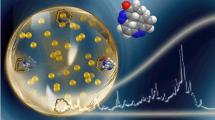Abstract
Molecularly imprinted nanospheres obtained by miniemulsion polymerization have been applied as the sensitive layer for label-free direct optical sensing of small molecules. Using these particles as the sensitive layer allowed for improving response times in comparison to sensors using MIP layers. As a model compound, well-characterized nanospheres imprinted against l-Boc-phenylalanine anilide (l-BFA) were chosen. For immobilization, a simple concept based on electrostatic adsorption was used, showing its applicability to different types of surfaces, leading to a good surface coverage. The sensor showed short response times, good selectivity, and high reversibility with a limit of detection down to 60 μM and a limit of quantitation of 94 μM. Furthermore, reproducibility, selectivity, and long-term stability of the sensitive layers were tested. The best results were achieved with an adsorption on aminopropylsilane layers, showing a chip-to-chip reproducibility of 22%. Furthermore, the sensors showed no loss in signal after a storage time of 1 year.




Similar content being viewed by others
References
Fechner P, Pröll F, Albrecht C, Gauglitz G (2011) Anal Bioanal Chem 400:729–735
Ruigrok VJB, Levisson M, Eppink MHM, Smidt H, van der Oost J (2011) Biochem J 436:1–13
Albrecht C, Fechner P, Honcharenko D, Baltzer L, Gauglitz G (2010) Biosens Bioelectron 25:2302–2308
Wulff G (1995) Angew Chem Int Edn 34:1812–1832
Mosbach K (1994) Trends Biochem Sci 19:9–14
Delaney TL, Zimin D, Rahm M, Weiss D, Wolfbeis OS, Mirsky VM (2007) Anal Chem 79:3220–3225
Brüggemann O, Haupt K, Ye L, Yilmaz E, Mosbach K (2000) J Chrom A 889:15–24
Vaihinger D, Landfester K, Kräuter I, Brunner H, Tovar GEM (2002) Macromol Chem Phys 203:1965–1973
Henry OYF, Cullen DC, Piletsky SA (2005) Anal Bioanal Chem 382:947–956
Moreno-Bondi MC, Navarro-Villoslada F, Ito-Pena E, Urraca JL (2008) Curr Anal Chem 4:316–340
Lotierzo M, Henry OYF, Piletsky S, Tothill I, Cullen D, Kania M, Hock B, Turner APF (2004) Biosens Bioelectron 20:145–152
Matsui J, Akamatsu K, Hara N, Miyoshi D, Nawafune H, Tamaki K, Sugimoto N (2005) Anal Chem 77:4282–4285
Hänel C, Gauglitz G (2002) Anal Bioanal Chem 372:91–100
Nopper D, Lammershop O, Wulff G, Gauglitz G (2003) Anal Bioanal Chem 377:608–613
Belmont AS, Jaeger S, Knopp D, Niessner R, Gauglitz G, Haupt K (2007) Biosens Bioelectron 22:3267–3272
O’Shannessy DJ, Br E, Mosbach K (1989) Anal Biochem 177:144–149
Weber A, Dettling M, Brunner H, Tover GEM (2002) Macromol Rapid Comm 23:824–828
Mohrle BP, Kumpf M, Gauglitz G (2005) Analyst 130:1634–1638
Lehmann M, Dettling M, Brunner H, Tovar GEM (2004) J Chrom B 808:43–50
Asenath Smith E, Chen W (2008) Langmuir 24:12405–12409
Mehne J, Markovic G, Pröll F, Schweizer N, Zorn S, Schreiber F, Gauglitz G (2008) Anal Bioanal Chem 391:1783–1791
Tovar G, Kräuter I, Gruber C (2003) Top Curr Chem Springer Berlin/Heidelberg
Acknowledgment
The work presented in this paper was funded by the “Biomimetischer Prozesssensor” research project funded by the Ministry of Science and Culture (Ministerium für Wissenschaft und Kultur), Baden Württemberg.
Author information
Authors and Affiliations
Corresponding author
Additional information
Published in the topical collection Biomimetic Recognition Elements for Sensing Applications with guest editor María Cruz Moreno-Bondi.
Electronic supplementary material
Below is the link to the electronic supplementary material.
ESM 1
(PDF 31.6 kb)
Rights and permissions
About this article
Cite this article
Kolarov, F., Niedergall, K., Bach, M. et al. Optical sensors with molecularly imprinted nanospheres: a promising approach for robust and label-free detection of small molecules. Anal Bioanal Chem 402, 3245–3252 (2012). https://doi.org/10.1007/s00216-011-5592-0
Received:
Revised:
Accepted:
Published:
Issue Date:
DOI: https://doi.org/10.1007/s00216-011-5592-0




